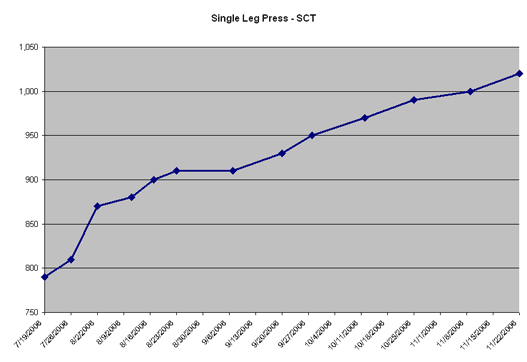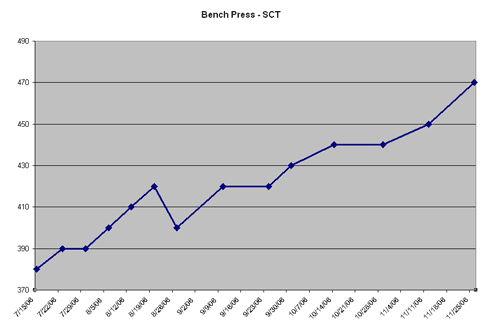UPDATE: the original article below describes my first four months training with SCT. Here are additional links to updated results:
Fitness Results Over One Year: Transforming My Body Through Fitness and Nutrition (January 13, 2008) Strength Training: Unpacking New “Streamline SR” Fitness Equipment (August 25, 2007) Fitness Results: Break Out Quarter! (Quarterly report, August 29, 2007: gained another 6.1 pounds of muscle; lost another 2.85 pounds of fat): Strength Training with Static Contraction Training: results after ten months (Quarterly report, May 17, 2007: gained another 1.2 pounds of muscle; lost another 2.95 pounds of fat ) Strength Training with Static Contraction Training: results after four months (November 23, 2006) To learn more about how to get started with Static Contraction Training, I recommend Pete Sisco’s excellent resource of training information on Static Contraction Training.
I joined Turner Athletic Club earlier this year. After building a base of cardiovascular fitness, I’ve added a type of strength training to my workout routine called “Static Contraction Training” (SCT) that has yielded outstanding results.
I started the program about four months ago and I’m amazed at the increase in strength I’ve achieved. My SCT benchpress has increased from 380 lbs to 470 lbs (24% gain); and my SCT single leg press has increased from 790 lbs to 1020 lbs (29% gain). I’ve had to switch from dual leg press to single leg press, because there are not enough weight plates in the gym to get to 2,000+ lbs I would need for a dual leg press – no kidding!
Two charts that show my progress:


I first heard about SCT from peak performance coach Tony Robbins. Developed by Pete Sisco and John Little, SCT generates ultra high intensity in each relatively short duration workout.
If you’re looking to to learn more about how to get started with Static Contraction Training, I recommend Pete Sisco’s excellent resource of training information on Static Contraction Training. Pete is the best!
What is SCT? In summary: starting from your strongest range of motion, lift the maximum (very heavy) weight possible and hold in a stationary (but not “locked out”) position for 5-10 seconds. If you can hold the weight for more than 10 seconds, it is too light.
Unlike traditional strength training, perform a single maximum intensity “rep” within only your strongest range of motion – and do not perform multiple sets. Instead of a 3x per week routine, each session is so intense that it is necessary to get 1 to 2 weeks of rest before your next workout.
Critically important: write down the amount of weight lifted, and the next week lift an even heavier weight.
There are three underlying principles:
- Muscles grow in response to high intensity overload.
- The higher the intensity of muscular output, the shorter the duration must be. (For example, you can run very fast but only for about 100 yards. Or, you can run for 26+ miles, but only at a slower speed.) If you want a very high intensity workout, it must be very short.
- To progress toward your physical goal, you need to increase the intensity of each workout. And the more intense your workouts, the more rest time you need between workouts.
Even though this workout is short in duration and only once a week, it is extremely physically and mentally demanding.
What I like about SCT:
Important: before attempting this yourself, read instructions from the experts, so you understand the safety equipment required. Stating the obvious: if you don’t use the required safety equipment, and you drop a 450 lb barbell on your chest, you could be seriously injured or worse.

Related strength training tip: I have been using NewGrips to cushion my palms and fingers and add strength to my grip so I can lift even heavier weights. NewGrips are made of neoprene and I’m finding are much better than traditional weight lifting gloves. I bought these, use them every workout and think these are the best weight lifting grips around. If you decide to get a pair, I’m linking to NewGrips with an affiliate link, meaning I get a token commission if you click from my link and purchase a pair of NewGrips from the manufacturer. – David Eckoff
UPDATE: the original article above describes my first four months training with SCT. Here are links to updated results:
Fitness Results Over One Year: Transforming My Body Through Fitness and Nutrition (January 13, 2008) Strength Training: Unpacking New “Streamline SR” Fitness Equipment (August 25, 2007) Fitness Results: Break Out Quarter! (Quarterly report, August 29, 2007: gained another 6.1 pounds of muscle; lost another 2.85 pounds of fat): Strength Training with Static Contraction Training: results after ten months (Quarterly report, May 17, 2007: gained another 1.2 pounds of muscle; lost another 2.95 pounds of fat ) Strength Training with Static Contraction Training: results after four months (November 23, 2006)
{ 1 trackback }
{ 3 comments… read them below or add one }
David
I read your blog and was interested to hear if your full range reps have increased as a result of the SCT training you have done.
Also, have you noticed a difference in lean muscle growth and tone?
Kind regards
Nigel Robinson
Hello, Nigel. Thanks for joining the conversation. Yes, my full range reps have increased as a result of SCT. I’ve definitely noticed a difference in lean muscle growth and tone. Visually. And measuring via hydrostatic body composition testing (the gold standard). What’s been your experience so far?
Guys, at 50 years old, I am stronger than I was in my 20’s thanks to SCT. The important thing to remember is to increase the time between workouts when your numbers don’t go up (i.e. total weight / minute lifting). As you do more and more, your body takes longer time to recover, and then build new muscle. I’m now doing 560 lb. Partials for bench press, and 2200 lbs. for partials on leg press. It works for cardio as well. Here’s my recent post to another blog:
Static Contraction Rules Applied to Cardio Vascular Workouts
The Video
Recently I watched a video made in the UK about exercise that I found on the Static Contraction web site: http://www.precisiontraining.com/. Studies show that while some people are “Resistant to exercise” regardless of time and effort, others show extreme progress. Your genes determine your results to a large extent. That said, that wasn’t the important finding.
Maximum Intensity
The important finding was this: Short duration, MAXIMUM INTENSITY exercise on an elliptical, treadmill, … of 15-20 seconds, ALL OUT, maximum speed and effort, Repeated 3-4 times, 3 times a week, provides the same, OR BETTER results as doing the Al Sears multi minute, “sprints”. (And no, you aren’t going to maintain an ALL OUT, NOTHING HELD BACK, POURING EVERYTHING INTO IT, sprint for a minute and a half. The 15-20 seconds will kick your hind end if you are really doing it. If not, raise the angle on your machine, or the resistance, until it does.)
Measurable Aerobic Progress
When you compare that to the “Intensity” measurements talked about on the static contraction site, you now have “Measurable” results in the heart and lung capacity department. For example, my elliptical has the ability to use arms and legs, so I do. I started at a level incline, and a low resistance of 5. I went all out for 15 seconds, my heart rate went up. When my heart rate dropped below 120, I went all out for another 15 seconds. I repeated that process one more time. Because my cardio “Stunk”, even though I only did 45 seconds of exercise, the entire process took me 1/2 hour.
Here’s the measurable progress part, remember how static contraction measures the weight lifted per period time, and how the weight / Time shows your progress? Well same thing here. I now do the 3 15 second all out sprints, with the cool down to a heart meat of 120 beats per minute in 10 minutes. Not only that, I now have the ramp at an angle of 12, and the resistance at 15. My revolutions per minute have increased, my recovery time cut down to 1/3 (Lowered the time), and the resistance / Angle is much more severe than when I started (Increased the load I moved.)
The Importance of a Medical Stress Test
To summarize, AFTER YOU GET THE DOCTOR’S PERMISSION, AND AFTER YOU GET A HEART STRESS TEST DONE, you might want to cut your workout time down to 15 seconds …
Proper Recovery (Increasing the Time Between Workouts)
No sense in not having measurable proof of your cardiovascular progress. I know that my health is improving. One more thing, as I am working on this program, I am noticing that I am hitting plateau’s just like I did when I was young and dumb, and lifted weights 3 times a week. I now do the (3) 15 second intervals once a week, and my results are AGAIN improving. It seems that recovery time needs to increase, as the level of effort/weight/intensity per minute increases as well. When I am not fully recovered, my ability on these sprints goes down (i.e. My revolutions in those 15 second intervals, at the same resistance/angle as the previous workout, go down.)
What this means is that if you want to keep seeing progress, cardio vascular wise, when you don’t see improvement between 2 workouts, (Everyone has a bad day once in a while. A bad 2 days shows you aren’t recovering.), increase the time before your next workout by 25%. I hope this helps.
Yes this will take away from your recovery time for strength training.
Anytime you create more of a load, drain, … on your bodies resources, your time to recover will increase. If you are lifting at the same time, just know that you are going to need more recovery time before you see improvements in that area if you add this to your program. Sorry boys and girls, physiology is what it is.
Mike